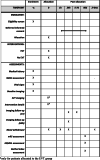MR CLEAN-LATE, a multicenter randomized clinical trial of endovascular treatment of acute ischemic stroke in The Netherlands for late arrivals: study protocol for a randomized controlled trial
- PMID: 33627168
- PMCID: PMC7903604
- DOI: 10.1186/s13063-021-05092-0
MR CLEAN-LATE, a multicenter randomized clinical trial of endovascular treatment of acute ischemic stroke in The Netherlands for late arrivals: study protocol for a randomized controlled trial
Abstract
Background: Endovascular therapy (EVT) for acute ischemic stroke due to proximal occlusion of the anterior intracranial circulation, started within 6 h from symptom onset, has been proven safe and effective. Recently, EVT has been proven effective beyond the 6-h time window in a highly selected population using CT perfusion or MR diffusion. Unfortunately, these imaging modalities are not available in every hospital, and strict selection criteria might exclude patients who could still benefit from EVT. The presence of collaterals on CT angiography (CTA) may offer a more pragmatic imaging criterion that predicts possible benefit from EVT beyond 6 h from time last known well. The aim of this study is to assess the safety and efficacy of EVT for patients treated between 6 and 24 h from time last known well after selection based on the presence of collateral flow.
Methods: The MR CLEAN-LATE trial is a multicenter, randomized, open-label, blinded endpoint trial, aiming to enroll 500 patients. We will investigate the efficacy of EVT between 6 and 24 h from time last known well in acute ischemic stroke due to a proximal intracranial anterior circulation occlusion confirmed by CTA or MRA. Patients with any collateral flow (poor, moderate, or good collaterals) on CTA will be included. The inclusion of poor collateral status will be restricted to a maximum of 100 patients. In line with the current Dutch guidelines, patients who fulfill the characteristics of included patients in DAWN and DEFUSE 3 will be excluded as they are eligible for EVT as standard care. The primary endpoint is functional outcome at 90 days, assessed with the modified Rankin Scale (mRS) score. Treatment effect will be estimated with ordinal logistic regression (shift analysis) on the mRS at 90 days. Secondary endpoints include clinical stroke severity at 24 h and 5-7 days assessed by the NIHSS, symptomatic intracranial hemorrhage, recanalization at 24 h, follow-up infarct size, and mortality at 90 days, DISCUSSION: This study will provide insight into whether EVT is safe and effective for patients treated between 6 and 24 h from time last known well after selection based on the presence of collateral flow on CTA.
Trial registration: NL58246.078.17 , ISRCTN19922220 , Registered on 11 December 2017.
Keywords: Acute ischemic stroke; Endovascular treatment; Late arrivals; Randomized controlled trial; Thrombectomy.
Conflict of interest statement
WvZ reports that Maastricht University Medical Center received compensation from Stryker® and Cerenovus® for consultations by WvZ. CM reports that Amsterdam UMC received research grants from CVON/Dutch Heart Foundation, European Commission, TWIN Foundation, and Stryker®; he is a shareholder of Nico-Lab.
Figures




References
Publication types
MeSH terms
LinkOut - more resources
Full Text Sources
Other Literature Sources
Medical

